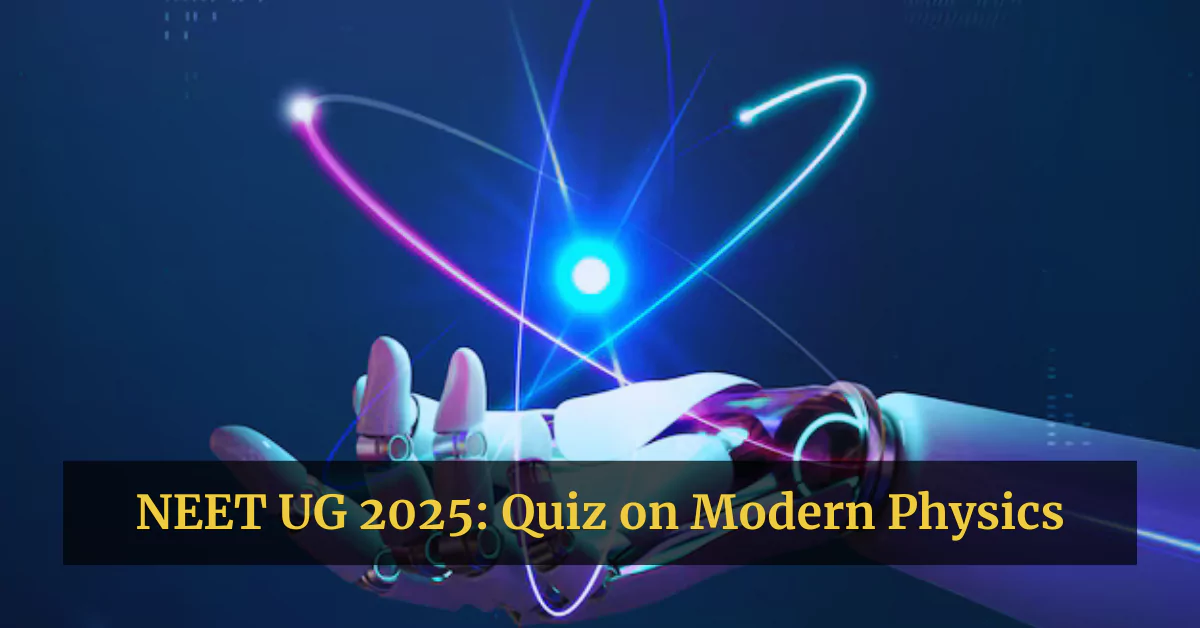NEET UG 2025: Modern Physics forms a critical component of NEET UG, often testing deep conceptual understanding with real-life atomic transitions. Here are 25 questions from the Modern Physics section of Physics. This is part of a series of sets curated by the edufever team for NEET aspirants. Solving this will be very helpful for students.
These questions are structured to challenge conceptual clarity and application in Modern Physics for NEET preparation.
Here are 25 challenging objective-type questions on Modern Physics for NEET UG 2025:
| NEET UG Counselling Guide 2025 | |
|---|---|
| State-wise MBBS/BDS Counselling Guide eBook 2025 | 📥 Download |
| MCC NEET UG Counselling Guide eBook 2025 | 📥 Download |
| AACCC AYUSH NEET Counselling Guide eBook 2025 | 📥 Download |
Modern Physics
1. In photoelectric effect, stopping potential increases with:
(a) Increase in intensity of incident light
(b) Increase in wavelength of light
(c) Increase in frequency of light
(d) Increase in number of photons
2. The work function of a metal is 2.0 eV. The maximum kinetic energy of emitted electrons when light of 400 nm is incident is:
(a) 0.1 eV
(b) 1.1 eV
(c) 2.1 eV
(d) 3.1 eV
3. A photon and an electron have the same de Broglie wavelength. Which has more kinetic energy?
(a) Electron
(b) Photon
(c) Both equal
(d) Depends on frequency
4. Statement I: In the photoelectric effect, increasing the intensity of incident light increases the number of photoelectrons emitted.
Statement II: The energy of the emitted photoelectrons increases with the intensity of the incident light.
Choose the correct option:
(a) Both Statement I and Statement II are correct, and Statement II correctly explains Statement I.
(b) Both Statement I and Statement II are correct, but Statement II does not explain Statement I.
(c) Statement I is correct, but Statement II is incorrect.
(d) Statement I is incorrect, but Statement II is correct.
5. The de Broglie wavelength of a particle is halved when:
(a) Its velocity is doubled
(b) Its energy is halved
(c) Its mass is halved
(d) Its momentum is halved
6. In a hydrogen atom, the ratio of the radius of the 3rd orbit to the 1st orbit is:
(a) 3
(b) 9
(c) 27
(d) 1/3
7. Which of the following transitions in hydrogen atom emits the maximum energy photon?
(a) n = 4 → n = 3
(b) n = 3 → n = 2
(c) n = 2 → n = 1
(d) n = 5 → n = 4
8. Which line of the Balmer series has the shortest wavelength?
(a) n=4→n=2
(b) n=3→n=2
(c) n=5→n=2
(d) n=∞→n=2
9. The energy required to remove an electron from the second orbit of hydrogen atom is:
(a) 3.4 eV
(b) 13.6 eV
(c) 1.51 eV
(d) 10.2 eV
10. The binding energy per nucleon is maximum for:
(a) Uranium
(b) Helium
(c) Iron
(d) Deuterium
11. The energy released in nuclear fission is primarily due to:
(a) Loss of mass
(b) Fusion of nucleons
(c) Absorption of neutrons
(d) Emission of electrons
12. Half-life of a radioactive substance is 10 days. The time taken for the activity to reduce to 1/8th is:
(a) 20 days
(b) 30 days
(c) 40 days
(d) 80 days
13. A radioactive element has a half-life of 5 years. In how many years will only 12.5% of it remain?
(a) 5
(b) 10
(c) 15
(d) 20
14. Assertion (A): Electrons in a hydrogen atom do not spiral into the nucleus despite being under electrostatic attraction.
Reason (R): Electrons in a hydrogen atom occupy only discrete energy levels due to quantization of angular momentum.
Options:
(a) Both Assertion and Reason are correct, and Reason is the correct explanation of Assertion.
(b) Both Assertion and Reason are correct, but Reason is not the correct explanation of Assertion.
(c) Assertion is correct, but Reason is incorrect.
(d) Assertion is incorrect, but Reason is correct.
15. Match Column I with Column II:
| Column I (Phenomenon) | Column II (Related Concepts) |
| A. Photoelectric Effect | 1. Quantization of angular momentum |
| B. Bohr’s Atomic Model | 2. Mass–energy equivalence |
| C. Nuclear Fission | 3. Emission of electrons by light exposure |
| D. de Broglie Hypothesis | 4. Wave nature of matter |
Options:
(a) A–3, B–1, C–2, D–4
(b) A–1, B–3, C–2, D–4
(c) A–2, B–4, C–3, D–1
(d) A–3, B–2, C–1, D–4
16. A photon of energy 5 eV ejects an electron with 3 eV kinetic energy. The work function of the metal is:
(a) 1 eV
(b) 2 eV
(c) 3 eV
(d) 5 eV
17. In Bohr’s model, angular momentum is quantized because:
(a) Electrons are particles
(b) Orbits are circular
(c) It is a postulate
(d) Electrons are stationary
18. Which of the following is not a feature of Bohr’s atomic model?
(a) Electrons revolve in discrete orbits
(b) Radiation is emitted only during transitions
(c) Orbits are elliptical
(d) Angular momentum is quantized
19. The wavelength associated with a 1 MeV electron is approximately:
(a) 10⁻¹² m
(b) 10⁻⁸ m
(c) 10⁻¹⁴ m
(d) 10⁻⁶ m
20. The total energy of an electron in the second orbit of hydrogen atom is:
(a) –13.6 eV
(b) –3.4 eV
(c) –1.5 eV
(d) +3.4 eV
21. The number of spectral lines produced in a hydrogen atom when an electron de-excites from n=5 to n=1 is:
(a) 4
(b) 5
(c) 10
(d) 6
22. In the Compton effect, increase in wavelength of scattered photon:
(a) Is proportional to incident photon frequency
(b) Depends on scattering angle
(c) Is independent of incident energy
(d) Depends on mass of nucleus
23. Which radiation has the highest penetrating power?
(a) Alpha
(b) Beta
(c) Gamma
(d) X-rays
24. Which series of hydrogen spectrum lies in the infrared region?
(a) Balmer
(b) Paschen
(c) Lyman
(d) Brackett
25. A photon of energy 12.75 eV is incident on a hydrogen atom in its ground state. The hydrogen atom absorbs the photon and gets excited to a higher energy level. What is the maximum wavelength of light that can now be emitted as the atom de-excites to a lower level?
(Take: Rydberg constant R=1.097×10^7 m^{-1})
Options:
(a) 656.3 nm
(b) 121.5 nm
(c) 102.5 nm
(d) 486.1 nm
✅ Answer Key:
1.(c), 2.(b), 3.(b), 4.(c), 5.(a), 6.(b), 7.(c), 8.(d), 9.(d), 10.(c), 11.(a), 12.(b), 13.(c), 14.(a), 15.(a), 16.(b), 17.(c), 18.(c), 19.(a), 20.(b), 21.(10), 22.(b), 23.(c), 24.(b), 25.(b)
Share your quiz scores in the comments section, and our experts will review your performance to provide personalized tips to help you improve your NEET score.
These questions are aimed at thoroughly testing conceptual depth, analytical thinking, and numerical proficiency in Modern Physics for NEET UG 2025 aspirants.


